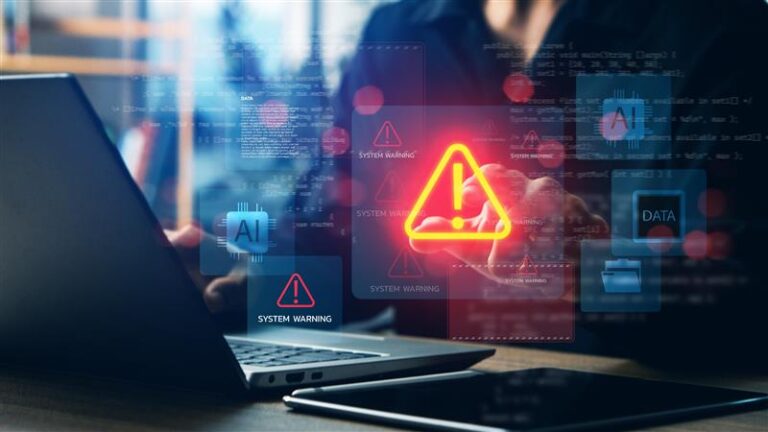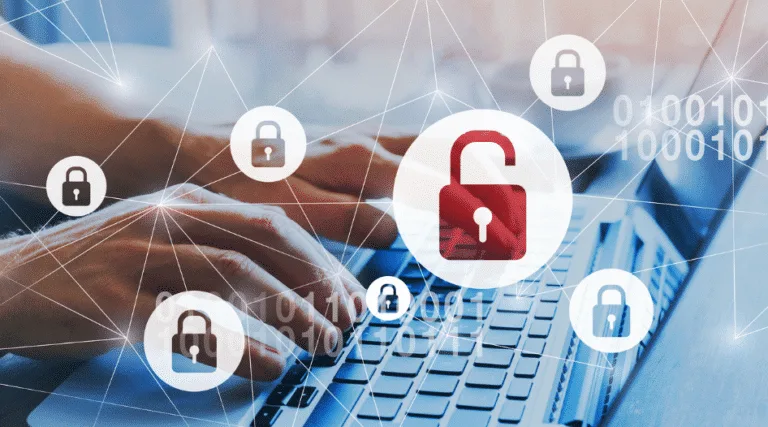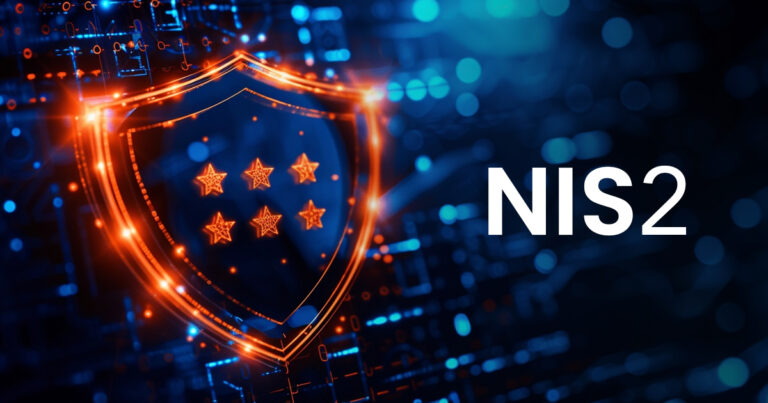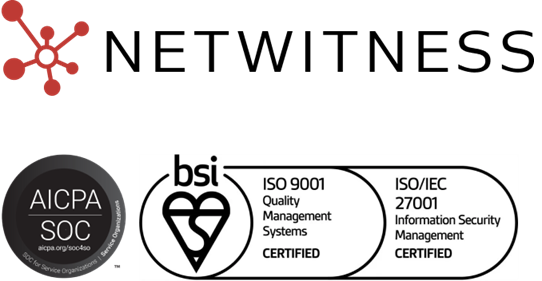Best practices and practical advice to protect your organization from external and internal threats.
A robust and effective incident response plan is no longer a luxury, it’s essential to a comprehensive cybersecurity strategy. From detecting early warning signs of a breach to ensuring swift and efficient recovery, a successful incident response plan relies on proactive measures, well-defined incident response steps, and continuous improvement.
Delving into the fundamental principles and best practices that drive a successful IR plan can empower your business to stay one step ahead of the ever-evolving cyber threat landscape and expertly handle cybersecurity incidents.
Security Incident Response Best Practices
From increasing awareness and preparedness to viewing time as a precious commodity, aligning organizational and technical plans, focusing on scoping, prioritizing documentation, and using the right tools to help, the following best practices can help your organization streamline and fine-tune your incident response process for the most success.
1. Increasing Awareness & Preparedness with Incident Response Essentials:
Although incident response plans are essential to managing security incidents effectively, they’re sometimes an afterthought. Ultimately, your organization can minimize the time required to remediate and reduce potential damages by ensuring awareness and preparedness in your incident response (IR) steps.
Whether you call it a plan or a policy, your entire organization should be familiar with the incident response team motions before an incident occurs. That means conducting annual tabletop exercises involving managers and team members from each department. It’s not simply a technical exercise–beyond those teams responsible for diagnosing and remediating an incident, don’t forget to include your legal, compliance, marketing, and any other teams involved in the incident response plan. These exercises may last several days and typically include practicing various scenarios and comparing the organization’s response plan to the actual unfolding of a prior event. While less mature companies might seek assistance from external organizations specializing in incident response services, more mature organizations might conduct these exercises independently with their incident response team.
Unfortunately, the importance of tabletop exercises is most apparent when organizations face disruptions, they are unprepared for, increasing the time and the pain it takes to resolve the issue–which is why a thorough incident response plan is necessary.
2. Viewing Time as a Precious Commodity:
Time is crucial for diagnosing and remediating issues. Since people tend to struggle with performing well under extreme pressure, a well-documented IR plan can help guide their actions during an incident, which is helpful regardless of its size or impact, and is a core part of professional incident response services.
The faster your organization can detect, contain, and remediate, the less damage a security incident can cause. Quick response times can prevent unauthorized access to sensitive information, minimize financial losses, and protect the organization’s reputation. It can also help reduce downtime and minimize service disruptions, ensuring the continuity of critical business operations through your incident response plan.
The longer it takes to respond, the more expensive and time-consuming the recovery process–highlighting the need for efficient security incident response steps as part of an IR plan.
3. Aligning Organizational Incident Response Strategies with the SOC:
Ideally, your organization’s overall incident response plan should align with the Security Operations Center (SOC) playbook to ensure a cohesive, efficient, and effective response. A well-coordinated incident response plan should define clear roles and responsibilities for incident response team members, ensuring everyone understands their part in the process.
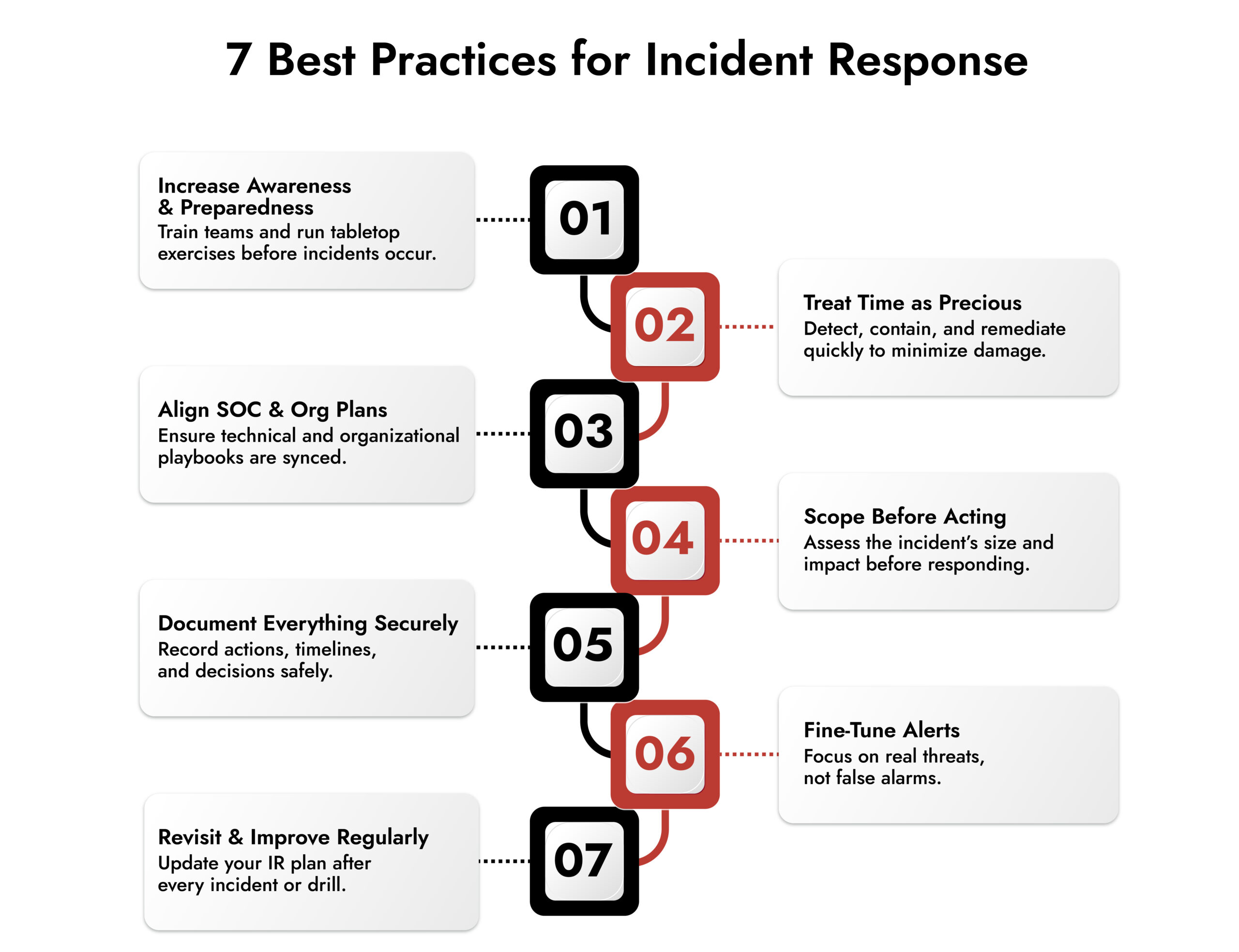
However, your organization’s overall approach might differ from the SOC’s in certain aspects.
Differences Between Organizational and SOC Incident Response Plans
While an organizational plan typically addresses the overall response strategies involving various departments and stakeholders, the SOC’s incident response plan typically focuses on the technical aspects of detection, analysis, and response.
For example, your SOC might rely on more detailed technical procedures, tools, and incident response steps specific to their activities and more detailed information on when and how to escalate incidents. In contrast, your organizational plan might have broader guidelines for the entire organization and outline reporting and escalation processes at a higher level.
Despite these differences, aligning the organization with the SOC can promote better management and reduce the overall impact of cybersecurity incidents.
1. Focusing on Scoping:
Scoping involves determining a security incident’s extent, impact, and nature. Understanding the scope can help your organization allocate resources and direct the right personnel, tools, and gear based on its severity and complexity, and is an essential part of any incident response plan.
In some cases, the scope could determine reporting requirements to regulatory bodies or law enforcement agencies, so proper scoping ensures that your organization can meet its legal and regulatory obligations.
Finally, understanding the scope is essential for conducting a thorough post-incident review, identifying areas for improvement, and applying lessons learned to future incident response plan efforts. Post-mortems are a valuable tool that should never be bypassed “because we’re too busy now that the incident is over.” Organizations should always include post-mortems as part of your IR plan.
2. Prioritizing Documentation in Incident Response:
Proper contemporaneous documentation can ensure that information about the incident, response efforts, and decisions is communicated effectively among incident response team members, stakeholders, and other relevant parties. Documenting the details–including the timeline, actions taken, and the findings–helps preserve critical evidence for later investigations and legal proceedings or to improve your organization’s future incident response plan and security posture.
However, when it comes to documentation and evidence collection – especially during a crisis–organizations should consider the following best practices for their incident response process.
3. Use Secure Communication Channels During Incident Response:
Some organizations rely on communication channels such as email for the document trail. However, email might not be the right place to store that documentation–especially while an event is ongoing, as the adversary might have access to corporate inboxes.
Be careful about how you communicate. Even communicating through a team’s existing collaboration channel could be compromising. Consider using a backup collaboration platform or a different audio-conferencing platform for communication during an incident with the incident response team.
4. Keep Your Incident Response Plan and Documentation in Digital Form:
Digitally documenting your organization’s incident response plan has several advantages over physical documentation, including easy access, sharing, storage, real-time updates, searchability, and version control. Moreover, backing up a digital copy is easy, while physical documentation may be vulnerable to physical damage, loss, or theft.
5. Revisit Your Incident Response Plan Regularly:
Regularly reviewing and updating your IR plan will ensure that it remains practical and relevant to your organization’s changing needs and the threat landscape. Thorough documentation of past cybersecurity incidents and response efforts can help you update the plan, incorporating lessons learned and addressing identified gaps. Exercise your IR plan at least once annually–it’s otherwise guaranteed to be out-of-date.
6. Maintain Backup Integrity in Incident Response Process:
Documentation also plays a crucial role in ensuring the integrity of backups by providing information on when you made backups and what data you backed up. Any issues encountered during the backup process. Maintaining accurate and up-to-date documentation of backups as part of the incident response plan can facilitate a swift recovery during data loss or system failure.
7. Coordinate with Disaster Recovery and Business Continuity Plans:
IR documentation often complements Disaster Recovery (DR) and Business Continuity Plans (BCPs), providing valuable information on potential threats, vulnerabilities, and mitigation strategies. This information can help your organization develop more effective and holistic recovery and continuity strategies, ensuring resilience in security incidents and disasters through a well-integrated IR plan.
Expanding Visibility Beyond a SIEM Solution for Incident Response
A traditional Security Information and Event Management (SIEM) solution can help your organization detect, investigate, and respond by providing a centralized platform for real-time monitoring, analysis, and management of security events.
SIEM systems aggregate and correlate logs from various sources, such as network devices, servers, applications, and security tools. This centralized log collection makes it easier for responders to identify patterns, trends, and anomalies that may reveal a need for incident response services. But having a SIEM in place is only the starting point, not the ending point, for comprehensive visibility across the environment.
Whether you believe that SIEM stands alone from a broader Extended Detection and Response (XDR) solution or is integrated within that XDR offering, your organization and the SOC cannot see everything it needs by relying on logs alone. Look for a wide-ranging XDR platform that provides native visibility into network traffic, endpoint activity, and logs. Ideally, XDR will also include analytics (User and Entity Behavior Analysis or UEBA) and workflows for the SOC (Security Orchestration, Automation, and Response or SOAR).
Fine-tuning alerts across all of these systems is also essential. Properly configured alerts ensure that security teams can identify, prioritize, and respond to potential threats while reducing the noise generated by false positives and irrelevant events.
Fine-Tuning Alerts:
Too many false positives can cause security teams to waste time and resources investigating non-critical events, diverting attention away from real threats. Fine-tuning alerts can minimize false positives, allowing security teams to focus on genuine incidents and reduce alert fatigue throughout the incident response process.
Fine-tuning alerts is an ongoing process that involves regularly reviewing and adjusting alert rules and organizational requirements. More mature organizations may have a dedicated “content”-focused individual or team responsible for the maintenance and upkeep of the rules, scenarios, and threat intelligence that generate the alerts–all essential parts of incident response services.
Building Incident Response Essentials That Fit Your Organization
Each organization has unique requirements and different levels of expertise. But for every organization, it is critical to identify gaps in the visibility and scope by finding all relevant evidence as part of their incident response plan. However, it can sometimes be challenging to determine how far back to look for evidence. Our advice is to follow the “breadcrumbs.” An XDR platform that stores network traffic, logs, and endpoint data for days, weeks, or even months provides plenty of those breadcrumbs which can ultimately diagnose and solve an incident.
Unfortunately, there is no “easy button.” Securing an organization is complex, always involving multiple vendors and platforms. Security architects also play a crucial role in the incident response plan by understanding and resolving gaps using a combination of technologies and workflows–and solutions are guaranteed to change over time.
Mastering the art of incident response process won’t happen overnight. As cyber threats become increasingly sophisticated, organizations must invest in robust IR strategies, training, and tools to stay ahead of the curve and maintain a strong defense against an increasingly unpredictable cyber landscape through a dedicated incident response team and incident response services.
How NetWitnes Can Help with Incident Response Orchestration
With advanced threat detection, investigation, and Incident Response (IR) capabilities, NetWitness helps organizations improve their security posture and respond to incidents more effectively by offering a range of incident response services and functionalities.
Incident investigation provides robust investigation and forensic capabilities that help security analysts quickly triage and investigate security events with advanced query capabilities, visualization tools, and enriched metadata, supporting your incident response plan.
Incident response orchestration helps streamline the IR processes with security orchestration, automation, and response (SOAR) capabilities, including features such as automated playbooks, case management, and collaboration tools for your incident response team.
Threat intelligence integration for staying up to date with the latest threats by integrating with external and internal threat intelligence feeds for enhanced detection and response capabilities as part of a comprehensive incident response plan.
Customization and scalability allow organizations to tailor the IR services to their specific needs and requirements to remain practical and relevant as they grow and their security needs evolve.
Learn more about how NetWitness can help your organization master the art of Incident Response (IR) and schedule a demo today.
Frequently Asked Questions
1. How to get better at incident response?
Enhance incident response capabilities through annual tabletop exercises engaging cross-functional teams. Prioritize detection and containment velocity, implement comprehensive XDR platforms for extended visibility, optimize alerts to reduce false positives, and establish mandatory post-incident reviews for continuous improvement.
2. What is an incident checklist?
An incident checklist is a structured framework that standardizes security incident response best practices across your organization.
Checklist components:
- Notification and escalation procedures.
- Required tools and system access protocols.
- Evidence collection and preservation methods.
- Secure communication channels.
- Containment, eradication, and recovery steps.
3. Why is having a well-defined incident response lifecycle important?
- Establishes clear protocols for rapid, coordinated action.
- Clarifies roles, responsibilities, and escalation criteria.
- Creates continuous improvement mechanisms.
- Enhances organizational resilience through refined incident response strategies.
- Aligns SOC technical playbooks with broader organizational objectives.
4. What are some effective strategies for containing a cybersecurity incident?
Containment strategies:
- Conduct thorough scoping to assess incident scope and business impact.
- Execute rapid isolation of compromised assets to prevent lateral movement.
- Deploy incident response orchestration platforms for automated workflows.
- Maintain comprehensive documentation throughout the incident response process.
- Utilize out-of-band communication channels to prevent adversary visibility.
5. What is the role of threat intelligence in incident response?
Threat intelligence delivers actionable context regarding threat actor tactics, techniques, and procedures (TTPs), accelerating incident analysis and response decisions. Integration of external threat feeds with internal intelligence enables faster pattern recognition, risk-based prioritization, and effective resource allocation for your security incident response team.

